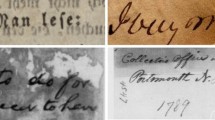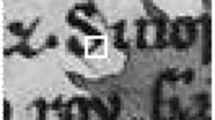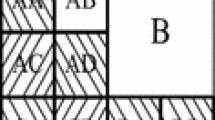Abstract
This paper presents a new method for degraded-document binarization, inspired by the attributes of the Human Visual System (HVS). It can deal with various types of degradations, such as uneven illumination, shadows, low contrast, smears, and heavy noise densities. The proposed algorithm combines the characteristics of the OFF center-surround cells of the HVS with the classic Otsu binarization technique. Cells of two different scales are combined, increasing the efficiency of the algorithm and reducing the extracted noise in the final output. A new response function, which regulates the output of the cell according to the local contrast and the local lighting conditions is also introduced. The Otsu technique is used to binarize the outputs of the OFF center-surround cells. Quantitative experiments performed on a set of various computer-generated degradations, such as noise, shadow, and low contrast demonstrate the superior performance of the proposed method against six other well-established techniques. Qualitative and OCR comparisons also confirm these results.














Similar content being viewed by others
References
Otsu N (1979) A thresholding selection method from gray-scale histogram. IEEE Trans Syst Man Cybern 9:62–66
Deravi F, Pal SK (1983) Gray level thresholding using second order statistics. Pattern Recogn Lett 1:417–422
Kapur JN, Sahoo PK, Wong AKC (1985) A new method for graylevel picture thresholding using the entropy of the histogram. Comput Vis Graph 29:273–285
Sahoo PK, Soltani S, Wong AKC (1988) A survey of thresholding techniques. Comput Vis Graph 41:233–260
Lee SU, Chung SY (1990) A comparative performance study of several global thresholding techniques for segmentation. Comput Vis Graph 52:171–190
Liu Y, Srihari SN (1997) Document image binarization based on texture features. IEEE Trans Pattern Anal Mach Intell 19(5):540–544
Cheriet M, Said JN, Suen CY (1998) A recursive thresholding technique for image segmentation. IEEE Trans Image Proc 7(6):918–921
Solihin Y, Leedham CG (1999) Integral ratio: a new class of global thresholding techniques for handwriting images. IEEE Trans Pattern Anal Mach Intell 21(8):761–768
Niblack W (1986) An introduction to digital image processing. Prentice Hall, New Jersey, pp 115–116
Mardia KV, Hainsworth TJ (1988) A spatial thresholding method for image segmentation. IEEE Trans Pattern Anal Mach Intell 10(6):919–927
Taxt T, Flynn PJ, Jain AK (1989) Segmentation of document images. IEEE Trans Pattern Anal Mach Intell 11(12):1322–1329
Parker JR (1991) Gray level thresholding in badly illuminated images. IEEE Trans Pattern Anal Mach Intell 13(8):813–819
Trier ØD, Jain AK (1995) Goal-directed evaluation of binarization method. IEEE Trans Pattern Anal 17(12):1191–1201
Sauvola J, Pietikainen M (2000) Adaptive document image binarization. Pattern Recogn 33(2):225–236
Yang Y, Yan H (2000) An adaptive logical method for binarization of degraded document images. Pattern Recogn 33:787–807
Ye X, Cheriet M, Suen CY (2001) Stroke–model–based character extraction from gray-level document images. IEEE Trans Image Process 10:1152–1161
Tsai CM, Lee HJ (2002) Binarization of color document images via luminance and saturation color features. IEEE Trans Image Process 11(4):434–451
Kim IK, Jung DW, Park RH (2002) Document image binarization based on topographic analysis using a water flow model. Pattern Recogn 35:265–277
Papamarkos N (2003) Document gray-scale reduction using a neuro-fuzzy technique. Int J Pattern Recognit Artif Intell 17(4):505–527
Dawoud A, Kamel MS (2004) Iterative multimodel subimage binarization for handwritten character segmentation. IEEE Trans Image Process 13(9):1223–1230
Sezgin M, Sankur B (2004) Survey over image thresholding techniques and quantitative performance evaluation. J Electr Imag 13(1):146–165
Oh HH, Limb KT, Chienc SI (2005) An improved binarization algorithm based on a water flow model for document image with inhomogeneous backgrounds. Pattern Recognit 38:2612–2625
Gatos B, Pratikakis I, Perantonis SJ (2006) Adaptive degraded document image binarization. Pattern Recognit 39:317–327
Badekas E, Papamarkos N (2007) Document binarization using Kohonen SOM. IET Image Process 1(1):67–84
Tseng YH, Lee HJ (2008) Document image binarization by two-stage block extraction and background intensity determination. Pattern Anal Appl 11(1):33–44
Vonikakis V, Andreadis I, Papamarkos N, Gasteratos A (2007) Adaptive document binarization. Proceedings of VISAPP, Barcelona, pp 104–110
Blakeslee B, McCourt M (2003) A multiscale spatial filtering account of brightness phenomena. In: Harris L, Jenkin M (eds) Levels of perception. Springer, Berlin, pp 47–72
Nelson R, Kolb H (2004) ON and OFF pathways in the vertebrate retina and visual system. In: Chalupa LM, Werner JS (eds) The visual neurosciences. MIT Press, Cambridge, pp 260–278
Fiorentini A (2004) Brightness and lightness. In: Chalupa LM, Werner JS (eds) The visual neurosciences. MIT Press, Cambridge, pp 881–891
Dacey DM, Lee BB (1999) Functional architecture of cone signal pathways in the primate retina. In: Gegenfurtner KR, Sharpe LT (eds) Color vision. Cambridge University Press, Cambridge, pp 181–202
Martin PR, Grunert U (2004) Ganglion cells in mammalian retinae. In: Chalupa LM, Werner JS (eds) The visual neurosciences. MIT Press, Cambridge, pp 410–421
Grossberg S (2004) Visual Boundaries and Surfaces. In Chalupa LM, Werner JS. The Visual Neurosciences, MIT Press, pp 1624–1639
Gupta MR, Jacobson NP, Garcia EK (2007) OCR binarization and image pre-processing for searching historical documents. Pattern Recognit 40:389–397
Acknowledgments
This work is funded: 75% by the EU, 25% by the Greek GSRT (PENED-03ED17). From private funding: for the 8.3 norm of the European Initiative “Competitiveness”—3rd Community Support Framework.
Author information
Authors and Affiliations
Corresponding author
Rights and permissions
About this article
Cite this article
Vonikakis, V., Andreadis, I. & Papamarkos, N. Robust document binarization with OFF center-surround cells. Pattern Anal Applic 14, 219–234 (2011). https://doi.org/10.1007/s10044-011-0214-1
Received:
Accepted:
Published:
Issue Date:
DOI: https://doi.org/10.1007/s10044-011-0214-1




